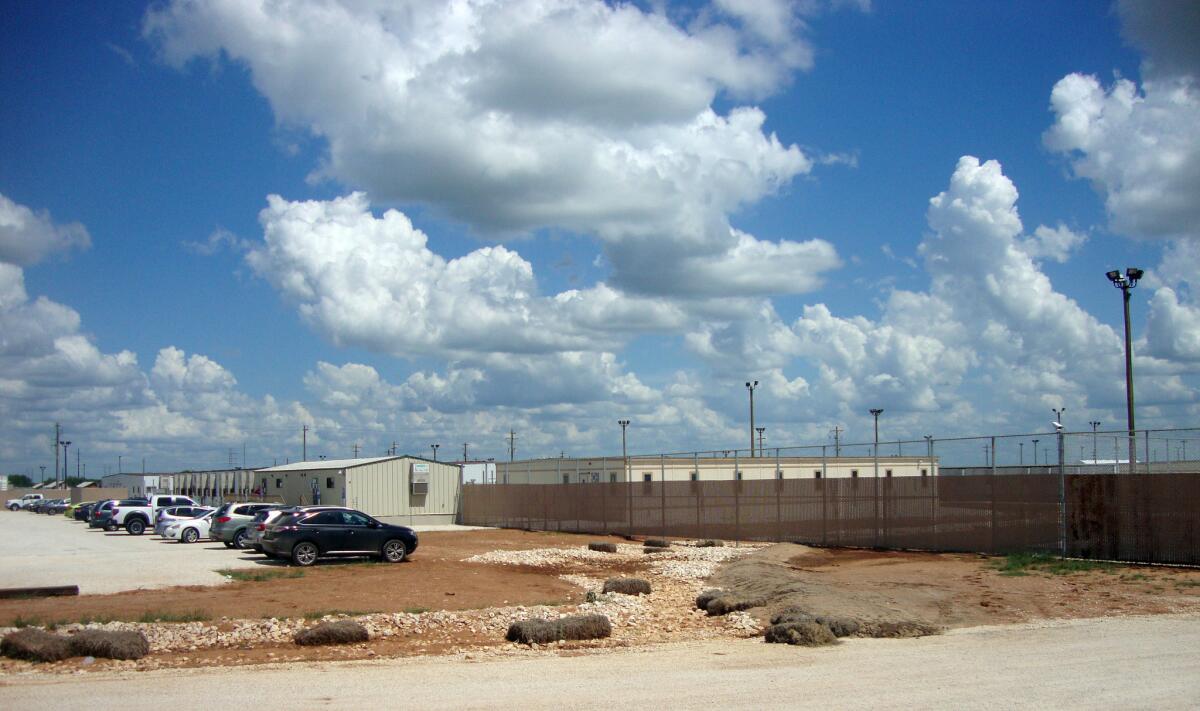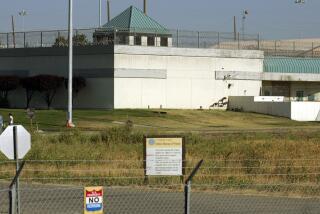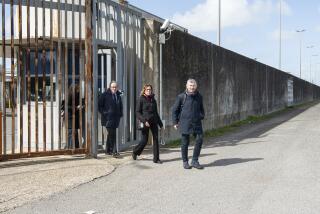Immigrant family detention centers are prison-like, critics say, despite order to improve

The South Texas Family Residential Center in Dilley, Texas, is the largest of the nation’s three immigration detention centers for families.
- Share via
Reporting from Houston — On deadline to improve immigrant family detention centers, Obama administration officials said they had converted the facilities into short-term processing sites, holding more families in recent months but for less time.
Immigrant advocates, however, say that conditions at the centers remain prison-like, with inadequate medical and legal services, despite a federal judge’s orders.
This summer, U.S. District Judge Dolly Gee in Los Angeles castigated federal officials, finding they had failed to meet conditions for detaining immigrant children established by a 1997 court settlement, Flores vs. Meese. The judge prohibited the administration from holding children at centers not licensed to care for them and from holding families unless they posed a flight risk or a threat to national security. She gave the administration until Friday to comply.
Government attorneys appealed the orders, arguing that the centers have made improvements and aim to hold immigrant families no longer than 20 days, which Gee has said “may fall within the parameters” of the Flores settlement.
“In light of the Oct. 23 deadline for compliance with the court’s Flores order, [Homeland Security] has worked diligently to ensure that we are in compliance with all aspects of the court’s order,” said Jennifer Elzea, a spokeswoman for the department’s Immigration and Customs Enforcement, which runs the centers.
Justice Department attorneys representing the administration in the case did not file proof Friday that they had complied with Gee’s orders and did not plan to, according to a spokeswoman.
She declined to comment about the case, noting the department has until February to file briefs in its appeal before the 9th Circuit Court of Appeals.
Opponents of family detention declared this a national week of action in cities across the country ahead of the Friday deadline, marching in Washington from the Justice Department to the White House and gathering with former detainees in Texas and New York.
Peter Schey, executive director of the Los Angeles-based Center for Human Rights & Constitutional Law, which filed the lawsuit, said that in the coming weeks his group would assess “whether we believe” the government is in compliance both with the Flores settlement and Gee’s orders.
If not, Schey said, “we would have to think about further intervention to seek from Judge Gee to require they come into compliance,” such as a contempt hearing, sanctions or an order appointing an independent special monitor.
“It does not appear to me that they are in compliance,” Schey said. “They’re continuing to hold children in lockdown, prison like-facilities with unrelated adults — that’s also a violation of Flores.”
The administration expanded family detention last year after more than 66,000 families, many from Central America, crossed the southern border. By year’s end, the country’s three family detention centers — two in Texas, one in Pennsylvania — are expected to expand to 3,700 beds.
Last week, there were 1,658 adults and children at the detention center in Dilley, Texas, compared with 658 before Gee’s most recent order in August, according to Brian Hoffman, lead attorney with the CARA Family Detention Pro Bono Project based at the center.
“We saw a rapid increase in the population” after the judge’s order, Hoffman said. “It seems to me they are sending more people here to keep the population at a certain level,” including younger children, some still being breast-fed.
The detention centers held about 2,100 family members this month, compared with 1,700 in July, when Gee issued her first order.
Last month, Homeland Security Secretary Jeh Johnson announced that family detention facilities were being converted into short-term processing centers where immigrants would be interviewed and screened quickly, “rather than detained for a prolonged period of time.”
“Family residential centers are an important part of the U.S. government’s comprehensive response to the increased number of undocumented families arriving at our borders,” said Jennifer Elzea, the ICE spokeswoman.
She called the facilities “an effective and humane alternative for maintaining family unity as families go through immigration proceedings or await return to their home countries.”
Elzea said the agency “ensures that these residential centers operate in an open environment, which includes medical care, mental health care, play rooms, social workers, educational services and … access to legal counsel.”
U.S. Rep. Raul M. Grijalva (D-Ariz.) said the Texas detention centers he visited this summer were “very moving and very, very depressing — and for our country, very embarrassing.”
He later met with Johnson, but said he saw a “toxic disconnect” between changes in family detention the secretary described “and what’s really going on.”
Last month, Grijalva proposed legislation that would replace family detention with lower-cost community-based monitoring.
He and most House Democrats have called on the administration to close the centers.
Mayra Vasquez had been detained for more than a month with her 9-year-old daughter at the Karnes City, Texas, center when officials told her this week that she was leaving — among 18 mothers and children, including one Guatemalan mother and child held for almost a year, who were transferred to the Pennsylvania facility.
Some advocates fear the move signals the Pennsylvania facility is becoming a long-term holding center, since it’s the only one state-licensed to care for children, in keeping with Gee’s order.
But the facility’s state license expires in February, and state officials said Friday that they didn’t plan to renew it unless the center stopped housing adults.
In Texas, officials have attempted to obtain licenses for the other two centers, but face opposition from some state and congressional lawmakers, who sent a letter of protest to the governor this week.
“They told us we have been here too long,” Vasquez, 27, said by phone before leaving the detention center Tuesday.
Vasquez fled Guatemala after a gang demanded money and threatened her daughter, and she explained her fears to an asylum officer during an interview.
“They didn’t believe me,” she said.
She was hoping to receive bond, but does not have a lawyer. “No one can help me,” she said.
Officials said that detainees may be moved among the centers based on bed space and other factors, but that they could not comment about individual cases.
Federal officials are on pace to detain 45,000 immigrant adults and children this year, compared with about 6,000 last year, at a cost of more than $400 million ($1,029 per day for a family of three), according to a report this week by New York-based Human Rights First.
Although families were previously held for months, some for more than a year, researchers who visited the centers recently found that most were detained from 10 days to six weeks. They found medical and legal services for the families lacking, alleging that some sick children failed to receive treatment and that some families were deported overnight without access to their attorneys.
Elzea, the ICE spokeswoman, responded by noting that since last month, the agency has been “using appropriate prosecutorial discretion and dedicating resources, to the greatest degree possible, to the removal of aliens considered priorities.”
For news on immigration and other national issues follow @mollyhf on Twitter.
More to Read
Sign up for Essential California
The most important California stories and recommendations in your inbox every morning.
You may occasionally receive promotional content from the Los Angeles Times.











